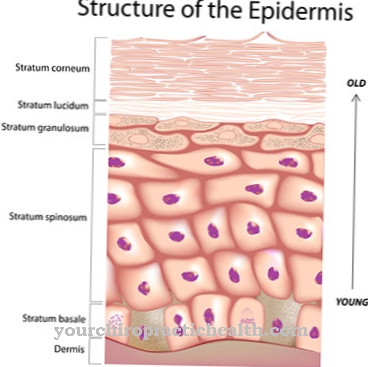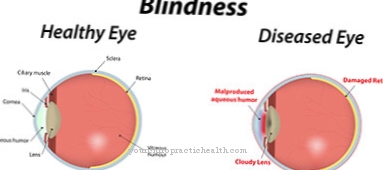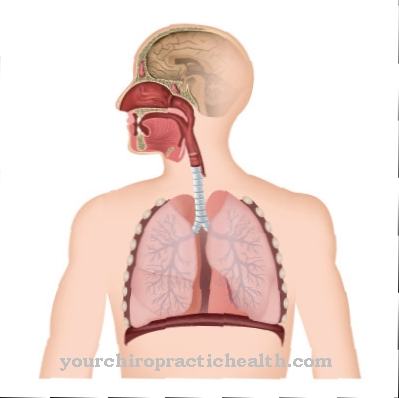At the Beemer-Langer Syndrome it is a disease that is usually counted among the so-called osteochondrodysplasias. The Beemer-Langer syndrome is synonymous in many cases with the term Short rib polydactyly syndrome Beemer type designated.
What is Beemer-Langer Syndrome?

© Spectral-Design - stock.adobe.com
From a medical point of view, Beemer-Langer syndrome is classified as one of the so-called short-rib polydactyly syndromes. The main symptoms of the disease are shortening of the rib bones and underdevelopment of the lungs. Beemer-Langer syndrome was first described in 1983 by Beemer, a Dutch genetics researcher, and Langer, a radiology specialist from the United States.
Basically, Beemer-Langer syndrome is a disease that has a genetic component. Because the syndrome exists from birth. The Beemer-Langer syndrome is characterized by the fact that the disease is fatal for the patient in almost all cases.
There is as yet no reliable information about the frequency of the occurrence of Beemer-Langer syndrome. However, it is known that the Beemer-Langer syndrome is passed on through an autosomal recessive inheritance. In addition to the typical malformations of the ribs and lungs, the affected patients in the context of Beemer-Langer syndrome also suffer in numerous cases from malformations of various internal organs.
For example, a case study of Beemer-Langer syndrome describes a female fetus that was born prematurely as a stillbirth. A narrowed thorax, shortened extremities and horizontal ribs were found. The bones of the limbs were bent. The lungs of the affected fetus were affected by hypoplasia.
causes
The exact causes that lead to the development of Beemer-Langer syndrome are still largely unexplored. However, previous observations and research regarding the disease have clearly shown that Beemer-Langer syndrome is inherited in children via an autosomal recessive route.
Basically, it can be assumed that a genetic defect is involved in the development of the disease. For example, it is possible that a mutation occurs on a certain gene. As a result, a defect develops that ultimately leads to the development of Beemer-Langer syndrome in the affected person.
You can find your medication here
➔ Medicines for painSymptoms, ailments & signs
In the context of Beemer-Langer syndrome, several different symptoms and signs are possible, which more or less clearly indicate the presence of the disease. In the majority of cases, the affected patients always share certain main symptoms.
On the one hand, this is a shortening of the ribs including hypoplasia of the thorax and pulmonary hypoplasia as well as an associated inadequate function of breathing. On the other hand, people suffering from Beemer-Langer syndrome have shortened and often bent long bones on their limbs.
In addition, defects in the heart, deformities of the ears and brachydactyly sometimes occur. In addition, in some cases, Beemer-Langer syndrome is associated with a number of potential complications. These include, for example, ambiguous sexual organs, ascites, a so-called hydrops fetalis and anophthalmos.
Diagnosis & course
Beemer-Langer syndrome is inherited and therefore exists from birth. Therefore, the typical features and symptoms of the disease develop already in the fetus in the mother's womb. This means that Beemer-Langer syndrome cannot be diagnosed in newborn children immediately after birth, but rather prenatally.
Sonographic examination techniques are usually used for prenatal diagnosis. Imaging of the unborn fetus in the womb gives more or less clear indications of the presence of Beemer-Langer syndrome, depending on the individual case. The diagnosis can be made primarily on the basis of the characteristic malformations of the ribs and extremities, which are already visible in fetuses.
The results of x-ray examinations often resemble those that occur in the context of Majewski's syndrome. One difference, however, is that the tibia is more strongly developed. However, in this case the patients do not show any hexadactyly, which makes a differentiation possible.
Complications
The main clinical symptoms of Beemer-Langer syndrome are shortened rib bones and underdeveloped lungs, which also determine the course of the disease and the fatal prognosis.The children suffer from various ailments and signs that more or less strongly indicate the presence of this hereditary disease. A complex of multiple malformations of different internal organs is characteristic.
Since the disease is passed on in an autosomal recessive mode of inheritance, the malformations that are classic for Beemer-Langer syndrome already manifest themselves before birth. For this reason, individual therapeutic approaches are not possible. The number of complex congenital pathological conditions is so great that the children are unable to survive. They are either born prematurely as a stillbirth or die a few hours after birth.
In addition to the shortened rib bones, many patients also have shortened and bent long bones on the limbs and a malformed thorax. Normal coordination and movement sequences are not possible. The underdevelopment of the lungs prevents normal respiratory function. Potential complications are heart defects and deformed ears and fingers, the absence of one or both of the eye primordia, and intersex sexual organs.
In many cases, the fetus has water retention in different parts of the body. These complications, known as hydrops fetalis, lead to further organic malformations such as ascites, pump weakness, liver cirrhosis, jaundice and edema.
When should you go to the doctor?
In many cases, the symptoms and complaints of Beemer-Langer syndrome are relatively ambiguous and do not directly indicate the disease. However, there are always breathing difficulties. Those affected can suffer from shortness of breath or gasping for breath. Should these complaints arise without a particular reason, a doctor should definitely be consulted. Heart problems can also occur in Beemer-Langer syndrome and must also be examined and treated by a doctor. Without treatment, in the worst case scenario, the affected person can die.
As a rule, ambiguous sexual organs also indicate Beemer-Langer syndrome. In most cases, however, these are recognized after birth, so that no further diagnosis by a doctor is necessary. Treatment and diagnosis are primarily carried out by the family doctor or the general practitioner. There the syndrome can be diagnosed. Further treatment is carried out by appropriate specialists who can adjust the individual complaints. Malformations or deformations of the extremities can also indicate Beemer-Langer syndrome and should be examined.
Doctors & therapists in your area
Treatment & Therapy
Basically, Beemer-Langer syndrome is a form of hereditary disease, as the disease exists from birth and even develops prenatally. For this reason, there are basically no options available or known to treat Beemer-Langer syndrome based on its causes. Instead, all attempts at treatment begin with the therapy of the existing symptoms.
In the case of Beemer-Langer syndrome, however, it should be noted that it is a disease with a fatal outcome in most cases. This means that the symptoms and malformations that are characteristic of Beemer-Langer syndrome lead to the death of those affected, as they are not viable for a long time.
The reason for the lethality of the Beemer-Langer syndrome lies, for example, in the hypoplasia of the lungs from which the sick patients suffer. Because as a result, the functions of the lungs, especially breathing, are severely impaired. As a result, the patient's organism is not adequately supplied with oxygen. However, the deformed and shortened extremities alone are not a reason for the premature death of the patient.
Outlook & forecast
In Beemer-Langer syndrome, causal therapy is generally not possible. Those affected can only take part in symptomatic treatment. There is also no self-healing and further concealment of the state of health if no doctor is consulted.
Those affected themselves suffer from an underactive breathing and are thus significantly restricted in their everyday life. Often this can also lead to chest pain. Heart defects and various deformities in the face also occur in Beemer-Langer syndrome and can therefore significantly reduce the life expectancy of the person affected. The heart defects are usually corrected by surgery. The deformities in the face and especially in the ears can also be corrected.
In some cases, the syndrome can also result in shortened extremities. These can only be treated to a limited extent with the help of prostheses, although this complaint does not have a negative effect on the life expectancy of the patient. In some cases, the difficulty breathing or the heart defect can lead to death a short time after birth. No treatments are possible to save the child.
You can find your medication here
➔ Medicines for painprevention
So far there are no known ways how the Beemer-Langer syndrome can be effectively prevented. Because the disease is inherited and develops before birth. It should also be noted that Beemer-Langer syndrome is usually fatal.
Aftercare
Follow-up care is usually not possible in Beemer-Langer syndrome. The disease itself cannot be completely treated, as it is a hereditary disease that is only limited symptomatically. It may also lead to a reduced life expectancy for the person affected.
However, the patient is dependent on regular examinations by a doctor in order to avoid further complications. The organism must always be supplied with sufficient oxygen in order to avoid further damage to the internal organs. The deformed extremities of the patient cannot be treated, so that the affected person has to get along with them for his entire life.
Since Beemer-Langer syndrome is often associated with aesthetic complaints, psychological treatment is also useful in order to avoid psychological complaints or moods. This can lead to bullying or teasing, especially with children. However, the parents can also take part in psychological treatment, as they are also affected by Beemer-Langer syndrome.
When planning further children, genetic counseling is useful to prevent the recurrence of Beemer-Langer syndrome. Since the exact symptoms of the syndrome depend very much on its severity, no general option for follow-up care can be given.
You can do that yourself
The Beemer-Langer syndrome is often associated with a long path of suffering for the affected child and the parents. In many cases, however, everyday life with the disease can be made easier with some measures.
Parents of a child with Beemer-Langer syndrome can first turn to the doctor and through him to various self-help groups. Organizations such as Orpha Selbsthilfe collect and provide information on rare hereditary diseases and show those affected how to deal with the disease in a life-affirming way. Exchanging ideas with other people affected can also be an important cornerstone for returning to a normal life.
Sometimes other therapeutic measures are useful to come to terms with the loss of your own child. In some cases, for example, couples therapy is recommended, while in other cases separate discussions with a therapist are the best solution. It is best to discuss with the doctor in charge which options are available for the relatives in detail. This can sometimes also show treatment options with which the child's life may not be saved, but which can possibly be extended by a few years.
























.jpg)



